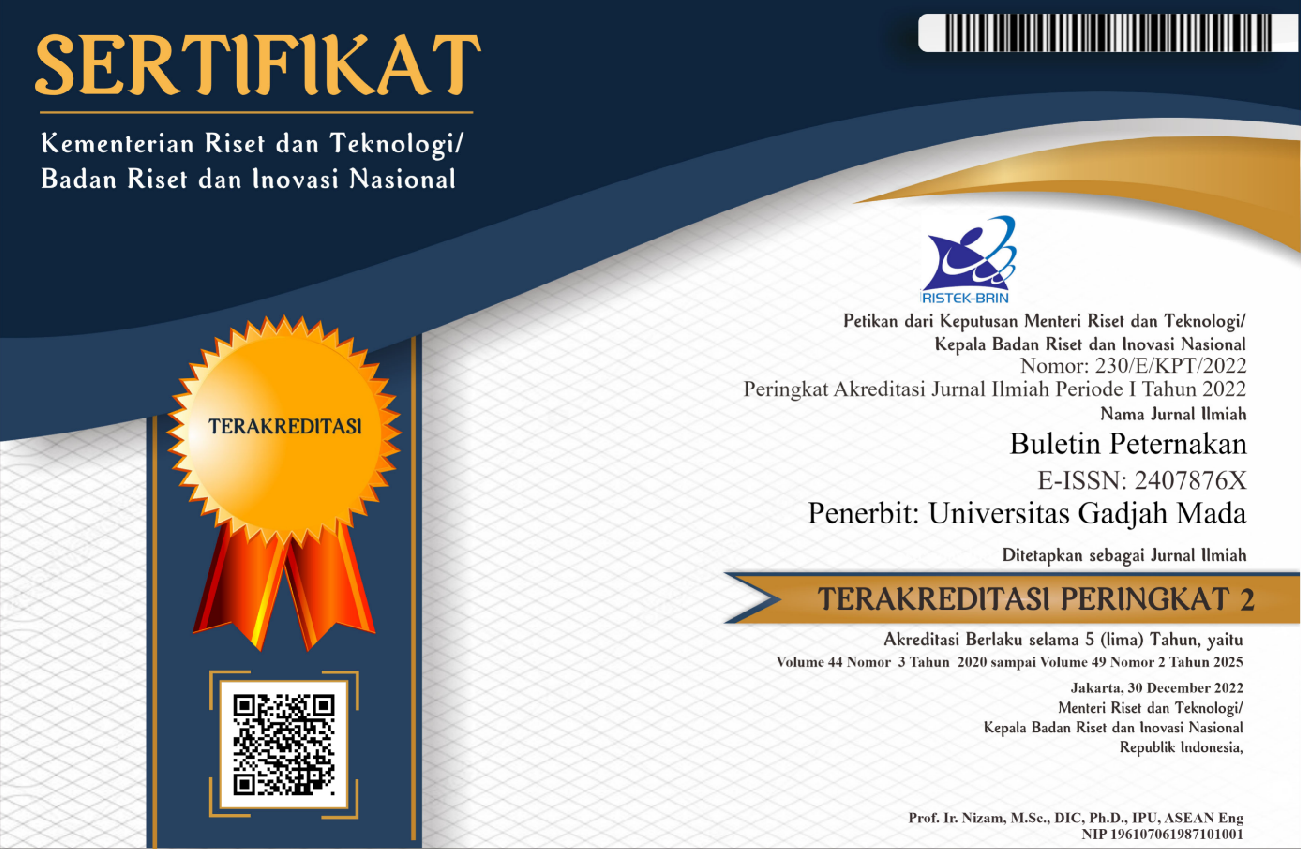Household Behavior and Response to the Participative Institutional Model for the Program of Handling Drainage of Productive Cows
Ardi Novra(1*), Bagus Pramusintho(2)
(1) Faculty of Animal Husbandry, Jambi University, Jambi, 36361, Indonesia
(2) Faculty of Animal Husbandry, Jambi University, Jambi, 36361, Indonesia
(*) Corresponding Author
Abstract
The research survey aimed to observe the households behavior and response to the participatory institution model of the preventing of the productive cows exploitation. The sample technique to select of the domestic cattle farmer (DCF) as the unit of analysis using the multiple stages cluster sampling and then sample allocation was equal for three districts. Structural equation model consisted of 5 behavior equations drawn up from the 5 endogenous and 13 exogenous variables. The research results showed that the rate of release of productive cows about 19.23 percent. The institutional model to handling of the drain at least productive cows have four major components, were members (DCFs), the management, micro-finance institutions (MFIs) and buffer-stock. The household motivation to develop the business scale and maintain the productive heifer shaped by land ownership and livestock scale expected factors. Then both types of motivation were not significantly associated with DCF's motivation to engage in institutional, as the more dominant individual as shaped by the farmer age. The other hand, the confidence level of participatory institutional effectiveness significantly shaped by the perception of institutional and potential release of productive heifer compared the potential release of motivation factors and correlated positively with the economic conditions.
Keywords
Full Text:
PDFReferences
AIAT of Central Java and Livestock Office of Central Java. 2005. Study of Cattle Slaughtering in Central Java. Collaboration between Assessment Institute for Agricultural Technology of Central Java and Livestock Office of Central Java.
Chilonda, P. and G. Van Huylenbroeck. 2001. A conceptual framework for the economic analysis of factors influencing decision making of small-scale farmers in animal health management. Rev. Sci. Tech. Off. Int. Epiz. 20: 687-700.
Directorate General of Animal Health and Husbandry. 2011. Technical Guidelines. Incentives and rescue for productive female cattle/buffaloes in 2011. Directorate General of Animal Health and Husbandry of Ministry of Agriculture of Republic of Indonesia, Jakarta.
Hafid, H. and A. Syam. 2001. Observation of the distribution and intensity of slaughtering of productive cows in slaughterhouses in the Municipality of Kendari. Research Report on the Faculty of Agriculture, University of Halualeo, Southeast Sulawesi.
Harmini, R. W. Asmarantaka, and J. Atmakusuma. 2011. The dynamic model of the national beef availability system. Journal of Development Economics (Jurnal Ekonomi Pembangunan) 12: 128-146.
Komarudin, H., Y. Siagian, C. Colfer, Neldysavrino, Yentirizal, Syamsuddin, and D. Irawan. 2008. Collective action to secure property rights for the poor: a case study in Jambi Province, Indonesia. CAPRi (Collective Action and Property Rights) Working Paper No. 90 June 2008.
Livestock Office of Jambi Province. 2007. Save Productive Cows - Prevent Slaughter. Agricultural Extension Worker Edition BPSDMP 10 – 16 October 2007. http://www.disnakjambi@deptan.co.id. Accessed January 12, 2012.
Mahbubi, A. 2014. Madura development program as an island cow perspective management of sustainable cattle supply. Agriekonomika: Journal of Socio-Economic and Agricultural Policy (Jurnal Sosial Ekonomi dan Kebijakan Pertanian) 3: 98-109.
Management Guidelines of Control of Productive Cow (PBP). 2013. Directive on how to save productive cows. Directorate General of Animal Health and Husbandry of Ministry of Agriculture of Republic of Indonesia, Jakarta.
Novra, A., and Depison. 2009. Alternative solutions for participatory institutional programs for productive cows. Journal of Animal Sciences (Jurnal Ilmu-ilmu Peternakan) 21: 1-10.
Satriawan, B. and H. Oktavianti. 2012. Efforts to alleviate poverty among farmers use a model of collective action on agricultural institutions. Journal of Development Economics (Jurnal Ekonomi Pembangunan) 13: 96-112.
Soedjana, T. D. 2009. A Bill of animal husbandry, slaughtering productive cows on the criminal. Director–General of Animal Husbandry, Department of Agriculture. https://lifestyle.kompas.com/read/2009/02/21/05023570/motong.sapi.betina.productive.dipidana. Accessed 02-21-2009.
Soejosopoetro, B. 2011. Study of slaughtering productive cows in Malang Slaughterhouse, Journal of Tropical Livestock (Jurnal Ternak Tropika) 12: 22-26.
Suardana, I. W., I. M. Sukada, I. K. Suada, and D. A. Widiasih. 2013. Analysis of the number and age of productive Bali cows slaughtered at the Slaughterhouse of Pesanggaran and Mambal Province of Bali. Journal of Veterinary Science (Jurnal Sain Veteriner) 31: 43-48.
Sudrajad, P., M. Mastur, and Subiharta, 2011. The performance of the development of beef cattle which is facilitated by the rescue program for productive cows in Central Java, Article of Agricultural Technology Assessment Center of Central Java at the National Seminar. Strengthening Agriculture Socio-Economy Towards Welfare. Faculty of Animal Science of UGM, Yogyakarta. December 8, 2011.
Squires, V. R. 2003. Social Behavior in Domestic Livestock: The Basis for Improved Animal Husbandry. Applied Animal Ethology 1: 177-184.
Article Metrics
Refbacks
- There are currently no refbacks.

This work is licensed under a Creative Commons Attribution-ShareAlike 4.0 International License.
Buletin Peternakan (Bulletin of Animal Science) Indexed by:

This work is licensed under a Creative Commons Attribution-ShareAlike 4.0 International License.










